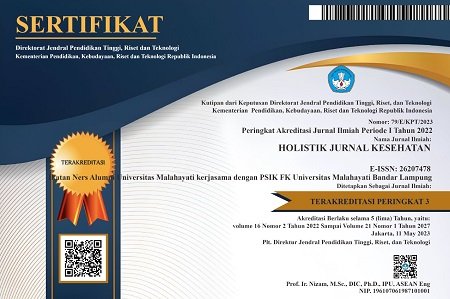Analisa faktor-faktor yang mempengaruhi intention masyarakat menggunakan platform telehealth pasca pandemi Covid-19
Abstract
Background: Telehealth is a form of health service innovation used during the Covid-19 pandemic where users can use this technology without having to go to the hospital for their health. The development of health services towards digitization has begun to develop in health services in Indonesia. Hospitals in Indonesia, especially in Jabodetabek, have adopted many telehealth services.
Purpose: To analyze the factors that influence people's intention to use telehealth so that they can develop telehealth innovations by looking at the dimensions of technology and users.
Method: The study was conducted using a quantitative approach with a cross-sectional design using primary data. The analysis used was univariate, chi-square test, and multiple linear regression test.
Results: From a total of 109 respondents it was found that the factors that most influenced community interest from the technology dimension were social support (p=0.005) and facilities and infrastructure (p=0.005) where the technology dimension obtained an R square of 0.917 while on the user dimension, the most influencing community intentions are perceived usefulness (p = 0.005) and perceived convenience (p = 0.005), where the user dimension factor has an R square of 0.874.
Conclusion: There is a relationship between perceived usefulness, perceived ease of use, and intention to use the community in using the telehealth platform in the community of Jabodetabek. The factors of perceived ease to use, perceived usefulness, social influence, and facilitating conditions are the factors that most influence people's intention to use telehealth in Jabodetabek.
Suggestion: The technology dimension factor and the user dimension are things that must be considered for the future development of telehealth technology so that patients are more loyal to reusing telehealth applications during the post-Covid-19 pandemic health digitalization.
Keywords: Community Intentions; Telehealth; Pandemic; Covid-19.
Pendahuluan: Telehealth merupakan bentuk inovasi pelayanan kesehatan yang telah dimanfaatkan di masa pandemi Covid-19 dimana pengguna dapat menggunakan teknologi tersebut tanpa berkunjung ke rumah sakit untuk kesehatannya. Perkembangan pelayanan kesehatan ke arah digitalisasi sudah mulai berkembang di pelayanan kesehatan di Indonesia. Rumah sakit di Indonesia khususnya di Jabodetabek sudah banyak mengadopsi layanan telehealth.
Tujuan: Untuk menganalisa faktor- faktor yang mempengaruhi intention masyarakat dalam menggunakan telehealth sehingga dapat mengembangkan inovasi telehealth dengan melihat dimensi technology dan user dimension.
Metode: Penelitian dilakukan dengan pendekatan kuantitatif dengan desain cross sectional menggunakan data primer. Analisis yang digunakan adalah univariate, uji chi square, uji regresi linear berganda.
Hasil: Dari total 109 responden ditemukan bahwa faktor yang paling mempengaruhi intention masyarakat dari dimensi teknologi adalah dukungan social (p= 0.005) dan factor fasilitas sarana dan prasarana dengan (p=0.005) dimana dimensi teknologi diperoleh R square sebesar 0.917 sedangkan pada dimensi user, yang paling mempengaruhi intention masyarakat adalah persepsi kemanfaatan (p =0.005) dan persepsi kemudahan (p=0.005), dimana faktor user dimension memiliki R square 0.874.
Simpulan: Terdapat hubungan perceived usefulness, perceived ease of use terhadap intention to use pada masyarakat dalam menggunakan platform telehealth pada masyarakat di Jabodetabek. Faktor perceived ease to use, perceived usefulness, social influence, dan facilitating condition adalah faktor yang paling mempengaruhi intention masyarakat dalam menggunakan telehealth di Jabodetabek.
Saran: Faktor dimensi teknologi dan dimensi pengguna merupakan hal yang harus dipertimbangkan untuk mengembangkan teknologi telehealth di masa yang akan datang sehingga pasien semakin loyal menggunakan kembali aplikasi telehealth di masa digitalisasi kesehatan pasca pandemic Covid-19
Keywords
References
Abdallah, A., Baabdullah, A. M., Rana, N. P., Tamilmani, K., & Dwivedi, Y. K. (2018). Technology in Society Examining adoption of mobile internet in Saudi Arabia : Extending TAM with perceived enjoyment , innovativeness and trust. Technology in Society, 55(March), 100–110. https://doi.org/10.1016/j.techsoc.2018.06.007
Ajzen, I. (1991). The theory of planned behavior. Organizational Behavior and Human Decision Processes, 50(2), 179–211.
Alam, M. Z., Hu, W., Kaium, M. A., Hoque, M. R., & Alam, M. M. D. (2020). Understanding the determinants of mHealth apps adoption in Bangladesh: A SEM-Neural network approach. Technology in Society, 61, 101255.
Alexandra, S., Handayani, P. W., & Azzahro, F. (2021). Indonesian hospital telemedicine acceptance model: the influence of user behavior and technological dimensions. Heliyon, 7(12). https://doi.org/10.1016/j.heliyon.2021.e08599
Ariyanti, S., & Kautsarina, K. (2017a). Techno-economic study on telehealth in Indonesia. Buletin Pos Dan Telekomunikasi, 15, 43–54.
Ariyanti, S., & Kautsarina, K. (2017b). Techno-economic study on telehealth in Indonesia. Buletin Pos Dan Telekomunikasi, 15, 43–54.
Barney, A., Buckelew, S., Mesheriakova, V., Raymond-Flesch, M., & Barney, A. (2020). The Covid-19 Pandemic and Rapid Implementation of Adolescent and Young Adult Telemedicine: Challenges and Opportunities for Innovation. Journal of Adolescent Health, 67, 164–171. https://doi.org/10.1016/j.jadohealth.2020.05.006
Bullock, D. R., Vehe, R. K., Zhang, L., & Correll, C. K. (2019). Telemedicine and other care models in pediatric rheumatology: An exploratory study of parents’ perceptions of barriers to care and care preferences. Pediatric Rheumatology, 15(1). https://doi.org/10.1186/s12969-017-0184-y.
Champion, V. L., & Skinner, C. S. (2008). The health belief model. Health Behavior and Health Education: Theory, Research, and Practice, 4, 45–65.
Chen, A. C., Rosenthal, D. N., Couch, S. C., Berry, S., Stauffer, K. J., Brabender, J., McDonald, N., Lee, D., Barkoff, L., Nourse, S. E., Kazmucha, J., Wang, C. J., Olson, I., & Selamet Tierney, E. S. (2019). Healthy hearts in pediatric heart transplant patients with an exercise and diet intervention via live video conferencing—Design and rationale. Pediatric Transplantation, 23(1). https://doi.org/10.1111/petr.13316.
Chowdhury, D., Hope, K. D., Arthur, L. C., Weinberger, S. M., Ronai, C., Johnson, J. N., & Snyder, C. S. (2020). Telehealth for Pediatric Cardiology Practitioners in the Time of Covid-19. Pediatric Cardiology, 41(6), 1081–1091. https://doi.org/10.1007/s00246-020-02411-1.
Cimperman, M., Makovec Brenčič, M., & Trkman, P. (2016). Analyzing older users’ home telehealth services acceptance behavior-applying an Extended UTAUT model. International Journal of Medical Informatics, 90, 22–31. https://doi.org/10.1016/J.IJMEDINF.2016.03.002
Dai, N. F. (2020). Stigma Masyarakat Terhadap Pandemi Covid-19. Prosiding Nasional Covid-19, 66–73.
Davis, F. D. (1985). A technology acceptance model for empirically testing new end-user information systems: Theory and results. Massachusetts Institute of Technology.
Davis, F. D., Bagozzi, R. P., & Warshaw, P. R. (1989). User acceptance of computer technology: A comparison of two theoretical models. Management Science, 35(8), 982–1003.
Fishbein, M., & Ajzen, I. (2011). Predicting and changing behavior: The reasoned action approach. Psychology press.
Fortini, S., Espeche, A., & Caraballo, R. (2020). Telemedicine and epilepsy: A patient satisfaction survey of a pediatric remote care program. Epilepsy Research, 165, 106370. https://doi.org/https://doi.org/10.1016/j.eplepsyres.2020.106370.
Imlach, F., McKinlay, E., Middleton, L., Kennedy, J., Pledger, M., Russell, L., Churchward, M., Cumming, J., & McBride-Henry, K. (2020). Telehealth consultations in general practice during a pandemic lockdown: survey and interviews on patient experiences and preferences. BMC Family Practice, 21(1), 1–14.
Kamal, S. A., Hussain, S., Shafiq, M., & Jahanzaib, M. (2018). The Nucleus Investigating the Adoption of Telemedicine Services: An Empirical Study of Factors Influencing Physicians’ Perspective in Pakistan. The Nucleus, 55(3), 153–163. www.thenucleuspak.org.pk.
Kamal, S. A., Shafiq, M., & Kakria, P. (2020). Investigating acceptance of telemedicine services through an extended technology acceptance model (TAM). Technology in Society, 60, 101212.
Kementerian Kesehatan Republik Indonesia. (2019). Peraturan Menteri Kesehatan Republik Indonesia Nomor 20 Tahun 2019 Tentang Penyelenggaraan Pelayanan Telemedicine Antar Fasilitas Pelayanan Kesehatan. In Menteri Kesehatan Republik Indonesia Peraturan Menteri Kesehatan Republik Indonesia: Vol. Nomor 6588 (Issue 879).
Khatun, F., Heywood, A. E., Ray, P. K., Hanifi, S. M. A., Bhuiya, A., & Liaw, S. T. (2015). Determinants of readiness to adopt mHealth in a rural community of Bangladesh. International Journal of Medical Informatics, 84(10), 847–856.
Nurhayati-Wolff, H. (2021). Number of internet users in Indonesia from 2017 to 2020 with forecasts until 2026 (in millions). Retrieved from Statista: https://www. statista. com/statistics/254456/number-of-internet-users-in-indonesia.
Oktavira, B. A. (2019). Aturan tentang Konsultasi Dokter Jarak Jauh (Telemedicine) - Klinik Hukumonline. https://www.hukumonline.com/klinik/a/aturan-tentang-konsultasi-dokter-jarak-jauh-itelemedicine-i-lt5db2b3d5e618b.
Pagliazzi, A., Mancano, G., Forzano, G., di Giovanni, F., Gori, G., Traficante, G., Iolascon, A., & Giglio, S. (2020). Genetic counseling during Covid-19 pandemic: Tuscany experience. Molecular Genetics and Genomic Medicine. https://doi.org/10.1002/mgg3.1433.
Pan American Health Organization. (2016). Framework for the Implementation of a Telemedicine Service. In Pan American Organization, World Health Organization (Issue May).
Panda, P. K., Dawman, L., Panda, P., & Sharawat, I. K. (2020). Feasibility and effectiveness of teleconsultation in children with epilepsy amidst the ongoing Covid-19 pandemic in a resource-limited country. Seizure, 81(July), 29–35. https://doi.org/10.1016/j.seizure.2020.07.013.
Payán, D. D., Frehn, J. L., Garcia, L., Tierney, A. A., & Rodriguez, H. P. (2022). Telemedicine implementation and use in community health centers during Covid-19: Clinic personnel and patient perspectives. SSM - Qualitative Research in Health, 2(November 2021), 100054. https://doi.org/10.1016/j.ssmqr.2022.100054
Puro, N. A., & Feyereisen, S. (2020). Telehealth Availability in US Hospitals in the Face of the Covid-19 Pandemic. https://doi.org/10.1111/jrh.12482
Qureshi, I. A., Raza, H., Whitty, M., & Abdin, S. Z. U. (2015). Telemedicine implementation and benefits for quality and patient safety in Pakistan. Knowledge Management and E-Learning, 7(3), 367–377. https://doi.org/10.34105/j.kmel.2015.07.024
Rimal, D., Huang Fu, J. H., & Gillett, D. (2017). Our experience in using telehealth for paediatric plastic surgery in Western Australia. ANZ Journal of Surgery, 87(4), 277–281. https://doi.org/10.1111/ans.13925.
Ryu, S. (2012). Telemedicine: Opportunities and Developments in Member States: Report on the Second Global Survey on eHealth 2009 (Global Observatory for eHealth Series, Volume 2). Healthcare Informatics Research, 18(2), 153. https://doi.org/10.4258/hir.2012.18.2.153
Siboro, M. D., Surjoputro, A., & Budiyanti, R. T. (2021). Faktor-Faktor Yang Mempengaruhi Penggunaan Layanan Telemedicine Pada Masa Pandemi Covid-19 Di Pulau Jawa. Jurnal Kesehatan Masyarakat (Undip), 9(5), 613–620. https://doi.org/10.14710/jkm.v9i5.30762.
Sisk, B., Alexander, J., Bodnar, C., Curfman, A., Garber, K., McSwain, S. D., & Perrin, J. M. (2020). Pediatrician Attitudes Toward and Experiences With Telehealth Use: Results From a National Survey. Academic Pediatrics, 20(5), 628–635. https://doi.org/10.1016/j.acap.2020.05.004.
Tao, D. (2009). Intention to use and actual use of electronic information resources: further exploring Technology Acceptance Model (TAM). AMIA Annual Symposium Proceedings, 2009, 629.
Tashkandi, E., Zeeneldin, A., AlAbdulwahab, A., Elemam, O., Elsamany, S., Jastaniah, W., Abdullah, S., Alfayez, M., Jazieh, A. R., & Al-Shamsi, H. O. (2020). Virtual management of patients with cancer during the Covid-19 pandemic: Web-based questionnaire study. Journal of Medical Internet Research, 22(6). https://doi.org/10.2196/19691
Tsai, C. H. (2014). Integrating social capital theory, social cognitive theory, and the technology acceptance model to explore a behavioral model of telehealth systems. International Journal of Environmental Research and Public Health, 11(5), 4905–4925. https://doi.org/10.3390/ijerph110504905.
Vidmar, A. P., Pretlow, R., Borzutzky, C., Wee, C. P., Fox, D. S., Fink, C., & Mittelman, S. D. (2019). An addiction model-based mobile health weight loss intervention in adolescents with obesity. Pediatric Obesity, 14(2). https://doi.org/10.1111/ijpo.12464
Widyapraba, E., Susanto, T. D., & Herdiyanti, A. (2016). Analisis faktor-faktor yang mempengaruhi niat pengguna untuk menggunakan aplikasi daftar online rumah sakit (studi kasus: RSUD Gambiran Kediri). SESINDO 2016, 2016.
World Health Organization. (2020). Implementing telemedicine services during Covid-19: guiding principles and considerations for a stepwise approach. Who, 2–2.
World Health Organization. (2022). WHO-ITU Global standard for accessibility of telehealth services. In Who (Vol. 4, Issue 1).
Yager, P. H. (2019). Pediatric rapid response systems beyond tertiary facilities: Is there a role for telemedicine? Pediatric Critical Care Medicine, 20(2), 198–199. https://doi.org/10.1097/PCC.0000000000001801.
Young, K., Gupta, A., & Palacios, R. (2019). Impact of Telemedicine in Pediatric Postoperative Care. Telemedicine and E-Health, 25(11), 1083–1089. https://doi.org/10.1089/tmj.2018.0246.
DOI: https://doi.org/10.33024/hjk.v17i2.9155
Refbacks
- There are currently no refbacks.
Copyright (c) 2023 Holistik Jurnal Kesehatan

This work is licensed under a Creative Commons Attribution-NonCommercial 4.0 International License.














